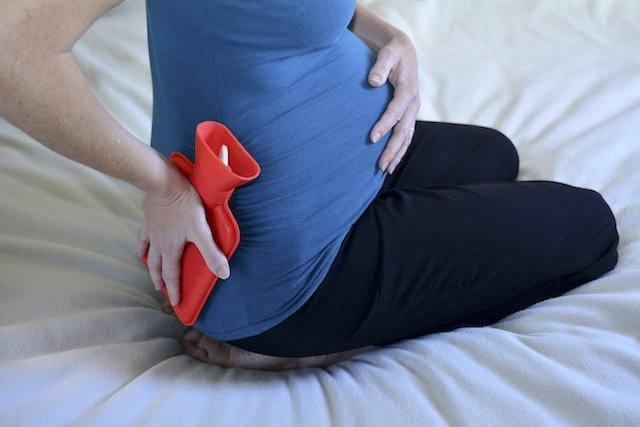Sciatic nerve pain during pregnancy is a relatively common condition and occurs when the weight of the belly overloads the spine and intervertebral discs. This can compress the sciatic nerve and cause pain that tends to worsen when you remain in the same position for a long time or when you perform heavier chores or activities.
Pain is typically felt in the lower back, and is described as heaviness or tightness, but it can also radiate to the legs. The nature of the pain may also change, and may feel like a stabbing or burning sensation.
If you notice these symptoms, you should inform your OB so that the need for medication or non-medicinal strategies can be recommended.

How to relieve sciatic nerve pain during pregnancy
Some strategies that can help relieve sciatic nerve pain during pregnancy include:
1. Physiotherapy
Physiotherapy should be guided by a physiotherapist who can use devices such as TENS and ultrasound, as well as manual and manipulative techniques, Kine tape, and heat packs to pain and discomfort. These interventions can also improve blood circulation and combat muscle spasms.
When sciatica flare-ups resolve, the physiotherapy may recommend exercises that strengthen the back muscles. Read more about sciatica and why it occurs.
2. Massage therapy
Massage therapy can help to reduce tension in the back and gluteal muscles, which may be worsening compression of the sciatic nerve. However, you should not massage the lower back too much as it can stimulate uterine contractions.
Therefore, to be safer, it is recommended to have seek massage therapy from a professional who is specialized in pregnancy care.
3. Cold compresses
Cold compresses help reduce inflammation of the sciatic nerve and relieve pain. They can be apply within the first 7 days of the onset of symptoms.
To make an ice pack, place ice inside a thermal bag or place a gel bag in the freezer to cool. Then wrap the bag or gel bag in a clean, dry towel and apply to the affected area for 15 to 20 minutes, 2 to 3 times a day.
4. Warm compresses
Warm compresses help to relax tense muscles, which can reduce muscle spasms and increase blood circulation. They can be applied after the first week, as the first days of symptoms should be dedicated to cool therapy to reduce sciatic nerve inflammation.
This compress can be prepared by adding hot water to a thermal bag. Wrap in a clean towel and apply to the affected area for 20 to 30 minutes, 2 to 3 times a day.
5. Stretching
Stretching is a great option for relieving inflammation in the sciatic nerve as it increases the strength of the muscles in the lower back, glutes and thighs, improves hip mobility and flexibility in the lower part of the body.
These stretches can be done twice a day with gentle movements, within your comfort and limitations to prevent further pain.
Also recommended: 8 Sciatica Stretches & Exercises for Pain Relief tuasaude.com/en/sciatica-stretches6. Pilates
Pilates helps to improve physical conditioning, blood circulation and increase mobility, as it aimed at both stretching and strengthening muscles to relieve sciatica pain.
Pilates exercises should be done as guided by a qualified health processional or physiotherapist.
7. Acupuncture
Acupuncture helps to rebalance any accumulated energy and can also help to relieve the symptoms of sciatica, especially when used in conjunction with other types of treatments.
Very intense, persistent symptoms should be assessed by your OB, who will assess the need and safety of sciatica medication.
How to prevent sciatica during pregnancy
To avoid sciatic nerve pain during pregnancy, it is important to:
- Perform light exercise regularly before and during pregnancy, such as dancing, yoga, clinical Pilates, swimming or water aerobics;
- Avoid gaining more than 10 kg (about 22lb) during pregnancy, as the more weight you gain, the greater the chance of compression and inflammation of the sciatic nerve;
- Use a pregnancy belt to help improve posture and prevent overloading the spine.
- Keep your spine straight when sitting, walking, standing, and, especially, when lifting weights from the floor;
- Avoid standing for long periods of time
If you begin to experience any pain or discomfort in your lumbar spine, you should take the opportunity to rest in a comfortable position for a while. However, absolute rest is not recommended and can worsen the situation. While sleeping, you can use a pillow between your legs when lying on your side, or a pillow below your knees when lying on your back.
